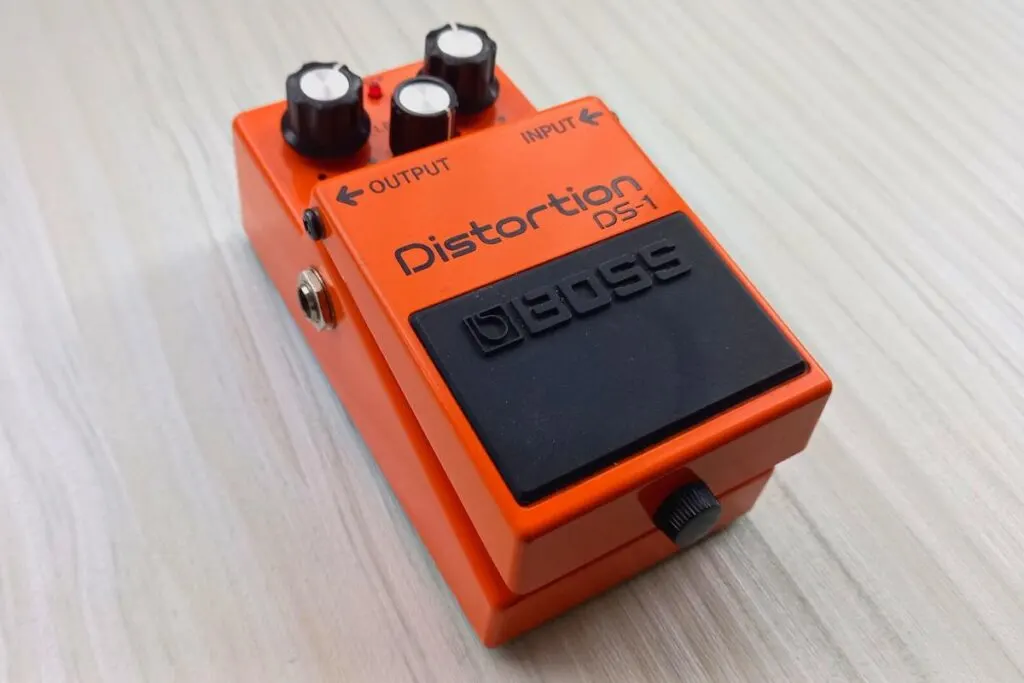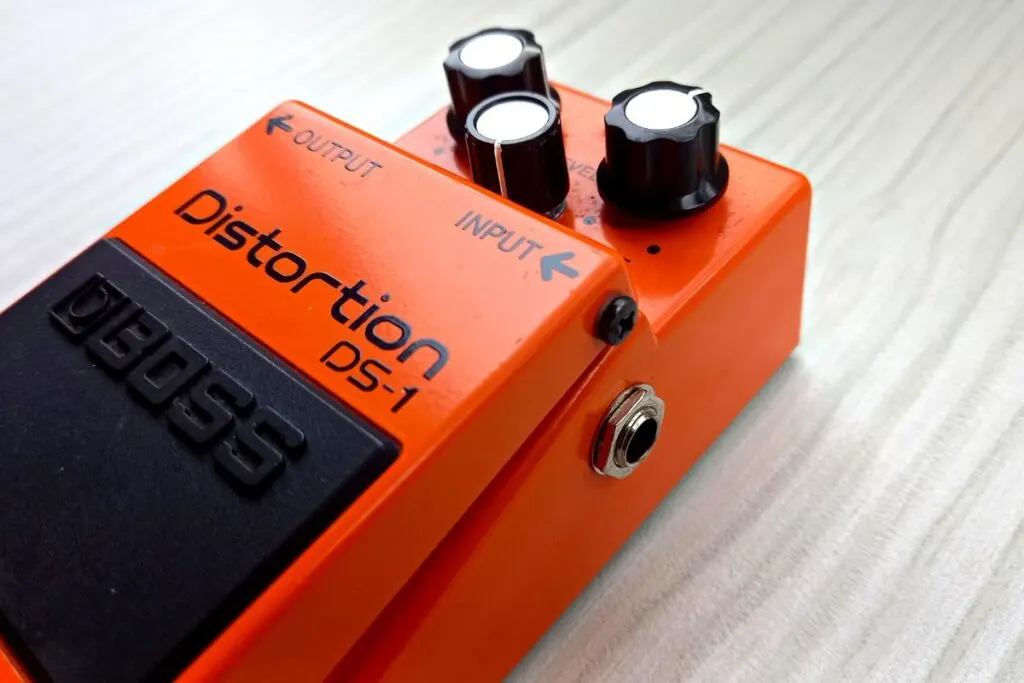The Boss DS-1 is probably the most famous distortion pedals in the world, dating all the way back to 1978. Since then, it’s been a staple of alternative rock tones, being used heavily by bands like Nirvana and Smashing Pumpkins.
I’ve owned my Boss DS-1 for a few years and have written this review to give you my unbiased perspective on this iconic pedal, sharing what I’ve learned during this time.
In this review, I’ve covered its key features, build quality, controls, and (most importantly!) how it sounds, with original sound clips and recordings by me.
It’s my hope that you come away from this knowing what the Boss DS-1 is good at, what it’s not so good at, and whether it’s the right pedal for you.
Affiliate disclaimer: This page contains affiliate links for products that I’ve tried and tested. As an Amazon Associate I earn from qualifying purchases at no additional cost to you. Learn more here.
Review summary of the Boss DS-1
The Boss DS-1 is a popular and affordable distortion pedal that makes a great first pedal for beginner guitarists.
Despite its low cost, it has a superb build quality and sturdiness. Mine has held up to years of use, both practicing and playing live.
Its strengths are in turning an amp into a gritty, beefy grunge machine (think Nirvana). But, it also excels at producing screaming leads, by giving heaps of brightness and sustain to your guitar tone.

That being said, it has a limited sound range. Its naturally thin sound starts to become shrill the more the pedal is turned up. This means that it can’t produce tones suitable for genres like hard rock or metal by itself.
I recommend the Boss DS-1 for any beginner guitar who wants a beefier sound from their practice amp. It’s low cost and high-quality makes it a solid choice.
I also recommend it for any guitarist looking for an authentic Lo-Fi grunge guitar tone.
If you’re further along in your guitar playing journey and are looking for a versatile distortion pedal, then this isn’t the one for you. It has a very narrow range of sound, and I think you’ll quickly hit up against its limitations.
You can check out its latest price here on Amazon.
Features
The Boss DS-1 follows the same design as other Boss “stompbox” pedals. It has a solid metal case (painted a vibrant tangerine orange) with three control knobs, and an input and output jack on the side.
Here’s a full list of the features:
- Sturdy metal body
- Three control knobs (level, tone, and drive)
- ¼ inch jacks for input and output
- Cavity for a 9v battery
- Power adaptor jack (Boss 9v PSA adaptor not included)
The Boss DS-1 is one of the original distortion pedals, so it set the framework for all those that followed. As you’d expect, newer pedals offer a wider range of features. But, they usually come with a price tag to match.

I find that the simple design makes this pedal instantly accessible to beginners, giving them everything needed to dial in a great distorted tone.
Another great feature is that it can be powered using either a mains adaptor or a 9v battery. This is pretty handy if you’ve ever forgotten to bring your adaptor to a gig (as I’ve done before…).
Build Quality
There’s nothing that I can fault about the DS-1’s build quality, especially considering its price.
As I said, it has a solid metal body that’s able to withstand some serious wear-and-tear. I’ve used this thing for practicing, recording, and playing live and it just won’t quit.
The jacks have remained solid and stable, with no “wiggle” and the heavy duty spring-mechanism shows no signs of giving out.
The control knobs are solid, too. However, they are made of plastic so they’re more likely to break, but I’ve not had this happen with any Boss pedal I’ve owned yet!
Controls
The Boss DS-1 has a very simple set of controls consisting of three knobs: tone, level, and distortion.
Both tone and distortion use chunky synth-style knobs, which are very easy to use for making quick changes. The level knob is much thinner, which can be a bit trickier to use.

I like the simplistic design. It’s clear and easy to use, and helps you to get straight into making music rather than fiddling around with different settings.
Let’s take a look at what the different knobs do.
Tone
The tone knob works by cutting either the bass or treble frequencies.
- When the knob is set to the middle position, there’s no frequencies being cut.
- Turning the knob to the left cuts the treble, leaving more low-end for a warmer, darker sound.
- Turning it to the right will cut the bass, leaving a sharper, sometimes shrill, tone.
To me, the tone knob can make or break the sound of the DS-1. I’ve covered it more in the sound examples, but turning this knob up too high can easily ruin your sound.
Level
The level knob sets the loudness of the pedal’s output. As you’d expect, turning it down makes the pedal quieter, and turning it up makes the pedal louder.
I find that it’s best to set the level so that there’s no difference in loudness to the pedal being on or off (which is called “gain staging”).
Distortion
The distortion knob sets the intensity of the effect. A lower setting means less (but still some) distortion. A max setting produces heavy distortion, which means lots of saturation, overtones, and sustain.
There’s a big difference between min and max on this pedal, which is great. I find that I can get anywhere from a slight bluesy-buzz to full on “wall-of-sound” dirt.
How it sounds
The Boss DS-1 is one of Boss’ most famous pedals, as such it’s been used by many influential artists over the years. Here’s a few people that have had the DS-1 on their pedal board:
- Billie Joe Armstrong (Green Day)
- Billy Corgan (Smashing Pumpkins)
- Joe Satriani
- John Frusciante (Red Hot Chilli Peppers)
- Kurt Cobain (Nirvana)
- Robert Smith (The Cure)
- Steve Vai
Broadly speaking, I think the Boss DS-1 excels at two things: grunge rock tones and vibrant, cutting leads.
Grunge tones
When I see that list, I’m not surprised that there’s a lot of grunge/alt-rock royalty in there. That’s because the DS-1 excels at taking a clean sounding amp and dragging it through the mud to give you some LoFi garage-rock grit.
Just take a listen to this sound clip of Nirvana’s “Smells Like Teen Spirit” that I recorded using the DS-1 through a clean amp.
Note: For all these clips, I’ve started them with the DS-1 on. I then repeat the phrase with the DS-1 off.
It gives heaps of character and attitude to that otherwise plain sounding guitar tone. By dialing up the distortion knob, you can get some heavily saturated sounds. Check out how it transforms Smashing Pumpkins chords.
So, the DS-1 is like a short-cut to getting an authentically 90s grunge/rock tone.
A common criticism of the Boss DS-1 is that it can sound tinny and thin, which I definitely agree with. A large factor in this is the tone knob. Setting the tone knob anywhere past 10 o’clock starts to sound too shrill for any rhythm tones.
To prove a point, I re-recorded the Nirvana riff changing only the tone knob by turning it to max. Have a listen (I’ll warn you, it’s not pleasant).
Pretty terrible, right? And that’s all from the pedal – nothing went wrong with the recording.
So, my takeaway is this: on a clean channel, the DS-1 will be able to give your guitar some true 90s rock power. But, that’s about it. It won’t be able to handle any high-gain genres like hard rock or metal. It just doesn’t have enough body.
But, it’s not all about rhythm. I think the DS-1 really shines when it comes to lead guitar.
Lead guitar tones
Putting this pedal on a slightly distorted amp helps give it a little push into full screaming lead glory. I bet that’s why Joe Satriani and Steve Vai are on the list.
Check out how the DS-1 gives wings to this rock lick.
The natural sharpness of the tone helps lead guitar parts to cut through a mix or live performance, while the saturation of the distortion gives it plenty of staying power.
If you start to think of this as a utility pedal, it really opens up some doors. By “utility” I mean using it alongside other pedals to add a little something extra.
I use this pedal to help add a slight, but noticeable, edge to any guitar solo that I want people to hear.
Again, it’s not all about wailing lead solos. By dialing back the distortion and tone knobs, I’m able to get some real rock-blues grit. Think Joe Bonamassa. Have a listen.
The DS-1 colors the signal, giving it a slightly thinner sound that is perfect at capturing a blues “faux-tweed” sound.
In that sense, it’s quite similar to its cousin, the Boss SD-1 overdrive pedal. This also colors your tone, but adds more body and less tinny-ness. You can check out my review of the Boss SD-1.
If you want to hear more sounds from the Boss DS-1, there’s an interactive demo on the official Boss website.
Final thoughts
The Boss DS-1 is one of the most iconic distortion pedals available today.
I think that it makes a great first pedal for beginners, due to its affordable price point and incredible build quality.
To me, it works best for giving authentic 90s grunge tones as well as adding sustain and edge to lead guitar parts.

It can sound a bit thin at times, especially with higher gain settings. So, I wouldn’t recommend it for rhythm guitarists looking to get their distorted guitar tone solely from this pedal.
Still, the Boss DS-1 is an incredibly affordable and reliable pedal. While it does have its limitations, I think that it’s worthy of a place on most pedal boards.
You can check out its latest price here on Amazon.
If you want to know anything else about the DS-1, leave me a comment down below!
Related questions

Conor is a music producer, multi-instrumentalist, and all-round enthusiast from the UK with over 15 years of experience. He’s the founder and sole-content creator for the roundtable audio blog and YouTube channel.
